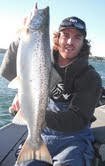|

Pike
Fishing
Ontario Ice Fishing Huts and Rentals

|
 Splake
Ė The Other Trout Splake
Ė The Other Trout
By: Tyler Dunn
Tyler Dunn Guiding
 Location Location
When you first approach a lake that has been
stocked with splake, begin the day at a spot you
would think splake will use to feed. I first
target aggressive splake on spots that I would
think they would use as an ambush spot to feed.
Rock points or even better under water points
are the usual starting points for me when I am
searching for splake through the ice. Action on
these points is usually short-lived because
splake much like the brook trout seem to travel
in small, ferocious packs rather than larger
schools like lakers. Quickly, I am off to the
next point or even rocky structure and so on
through most of the good looking rock areas. If
these spots donít produce, I will usually move
to the closest bay that offers some sort of
creek or water source. This constant flow of
food usually has a population of splake nearby
that will user these types of bays to roam and
feed in.
 Jigging
Presentations Jigging
Presentations
Just like brook and lake trout, splake will feed
on a vast variety of artificial lures. Most
recently Lindyís Little Flyer has become the
newest addition to my confidence baits. I tend
to use this spoon on or close to bottom.
Pounding, raising and then pausing. If I`m
jigging slightly off bottom I almost always keep
this spoon moving. A smooth, consistent jigging
rhythm works this lure to perfection and is a
deadly choice when you are searching for active
fish. Other common spoons on any splake lake
will include Bay De Nocís Swedish Pimple or
Northlands Buckshot. The entire time I`m jigging
my eyes are glued to my flasher looking for any
signs of life. When the flasher does mark a fish
that doesn`t seem aggressive or is just on the
edge of my flashers cone and is going to take
some finesse to entice a strike. Try to not only
to get the attention of the fish but try to make
the fish chase your offering. Once they begin to
chase your lure especially up, it`s usually game
over for them.
Dead Sticking
I spend a lot of time north of Sault
Ste. Marie, Ontario in Lake Superior Provincial
Park and like most other places in Ontario we
are allowed two lines per person on the ice.
This allows each angler to dead stick baits even
if they decide to jig. A great technique for
splake is actually a
 favourite
of mine for perch. Simply jig aggressively in
one hole and have a rod in a holder at another
only a few feet away. The idea is fish that come
in to check out my jigging presentation and
decide it`s not for them will have a second more
subtle offering for them to take on their way
out. A Northland forage minnow tipped with a
small shiner or packed with waxies is a great
option on any splake lake. Use live minnows were
permitted but in many cases such as LSPP only
dead are allowed. favourite
of mine for perch. Simply jig aggressively in
one hole and have a rod in a holder at another
only a few feet away. The idea is fish that come
in to check out my jigging presentation and
decide it`s not for them will have a second more
subtle offering for them to take on their way
out. A Northland forage minnow tipped with a
small shiner or packed with waxies is a great
option on any splake lake. Use live minnows were
permitted but in many cases such as LSPP only
dead are allowed.
Tip-up
Baits used for dead sticking can also
be used under a tip-up. The only difference I
have found is the fish taken on a tip-up are
often gut hooked. Most of the fish I throw on
the ice for a meal come from my tip-up. With
splake being a 100% put and take fishery in
Ontario I will usually harvest a few fish on
each outing. I personally keep it simple under a
tip-up. I run 8 pound monofilament to a 6 or 8
pound monofilament leaders. The longer the
leader the more room a live minnow has for
swimming around. The shorter leaders leave less
room for the minnow to move around with. Above
the barrel on my leader is just a small egg
sinker or split shot depending on how deep I
plan to fish. Although a tip-up is a very
effective tool for catching fish, let alone any
species. I usually dead stick until I find a
spot that I hunker down and spend an extended
amount of time at. Until then itís dead sticking
for me as I move.
|